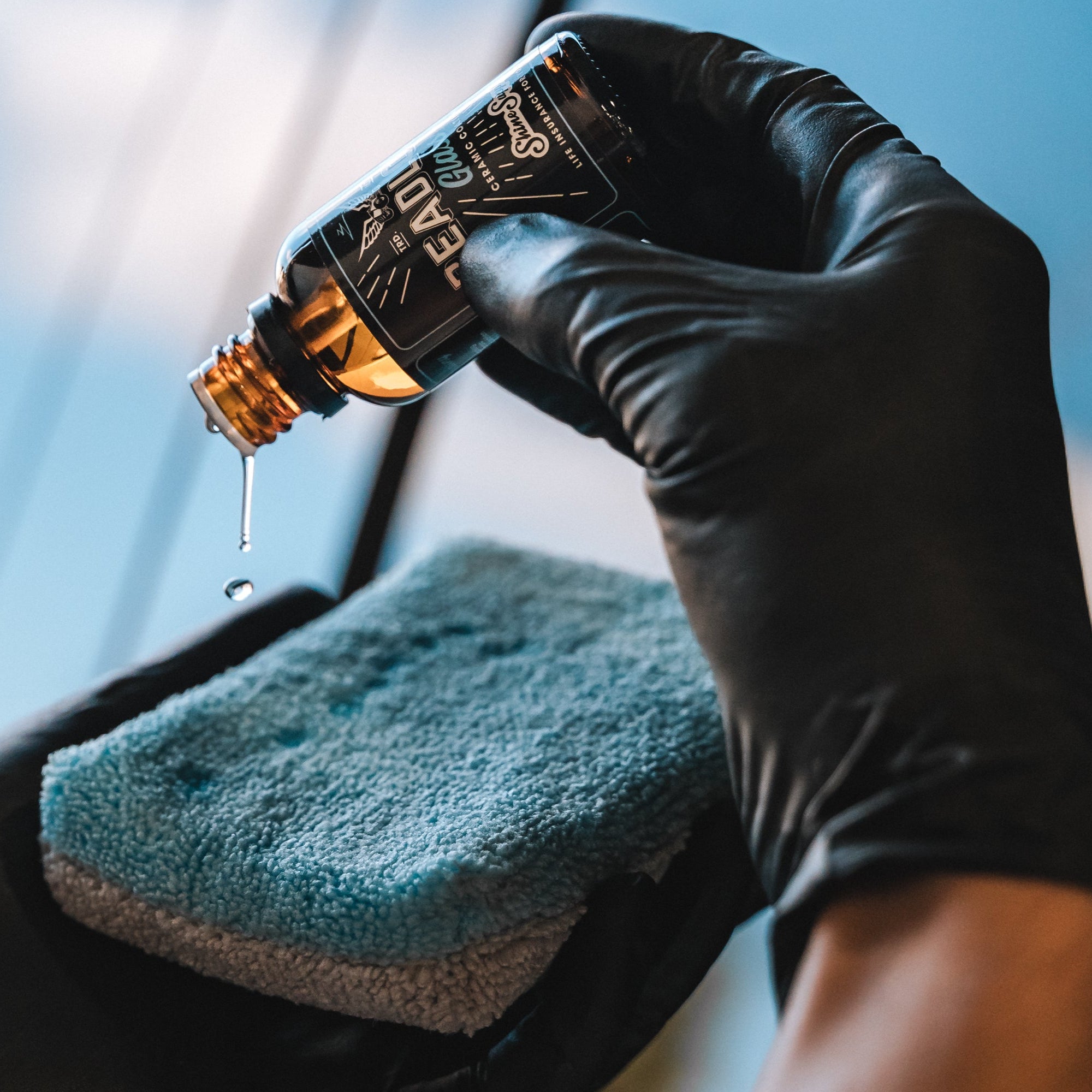Everything to know about Ceramic Coating Newark before scheduling an appointment
Exploring the Science Behind Car Ceramic Coating and Its Protective Residences
The scientific research of car ceramic coating offers an interesting research in innovative auto security. Composed mainly of silicon dioxide and polymers, these finishings develop a durable bond with lorry paint. This communication enhances sturdiness versus environmental hazards while offering hydrophobic benefits. Nevertheless, the intricacies of just how these finishes work and their long-lasting advantages remain much less understood. Unloading these information exposes why ceramic layers are coming to be a recommended selection for automobile care
What Is Ceramic Coating?
Ceramic coating is a fluid polymer that chemically bonds to the surface area of a lorry's paint. This advanced safety layer enhances durability and uses exceptional resistance to environmental elements. Unlike conventional wax or sealers, which supply temporary security, ceramic coverings develop a resilient shield that can withstand harsh problems such as UV rays, acidic pollutants, and extreme weather. When applied properly, the coating forms a hydrophobic surface, triggering water to grain and slide off, which aids in preserving the lorry's cleanliness. Additionally, it supplies enhanced gloss and depth to the paint, making the car appear more sleek and vivid. The application procedure typically entails complete surface preparation, including cleaning and polishing, to guarantee peak bonding. Because of this, ceramic coverings are becoming increasingly preferred amongst car lovers and those seeking to protect their financial investments, assuring to preserve the automobile's visual allure while decreasing the regularity of upkeep.
The Make-up of Ceramic Coatings
The complex solution of ceramic layers mainly contains silicon dioxide (SiO2), which is derived from natural resources like quartz and sand. This essential part gives the foundation for the coating's toughness and protective qualities. In enhancement to SiO2, ceramic coverings typically consist of various polymers and ingredients that enhance bond, versatility, and resistance to environmental factors. These compounds function synergistically to develop a robust obstacle against impurities such as dirt, chemicals, and UV rays.Furthermore, some formulas incorporate titanium dioxide (TiO2) or other nanomaterials, which can enhance the coating's hydrophobic residential or commercial properties, leading to better water repellency. The exact composition can vary considerably amongst producers, affecting efficiency and durability. Ultimately, the mix of these components culminates in a protective layer that not only improves the visual appeal of vehicles yet likewise serves to lengthen their life-span by shielding the surface from potential damage.
How Ceramic Coatings Work
Understanding just how ceramic coverings work involves exploring their chemical structure, which contributes to their protective top qualities. The application process is essential for achieving excellent outcomes, while longevity and longevity aspects identify the coating's performance over time. With each other, these aspects highlight the benefits and performance of ceramic finishings for automobile protection.
Chemical Make-up Explained
While numerous car proprietors seek long-lasting protection for their lorries, the chemical make-up of ceramic coverings plays a vital function in their effectiveness. These coverings largely include silicon dioxide (SiO2), which is originated from all-natural minerals. This substance creates a solid bond with the lorry's paint, creating a long lasting, protective layer. In addition, several ceramic layers include titanium dioxide (TiO2), boosting their hydrophobic residential or commercial properties and resistance to UV rays. The existence of polysiloxanes can additionally improve adaptability and sturdiness. Together, these components add to the coating's capability to fend off water, dust, and contaminants, while additionally providing a high-gloss surface. Understanding this chemical foundation aids car owners value the robust defense used by ceramic coverings.
Application Process Introduction
Using ceramic finishes entails a meticulous procedure that assures suitable bonding and security for the car's surface. Extensive cleansing and purification of the car's exterior are executed to eliminate dirt, gunk, and previous waxes. This action confirms that the surface area is without pollutants that could hinder bond. Following this, the paint is often brightened to boost clarity and eliminate any kind of flaws. As soon as prepared, the ceramic coating is applied in little areas using an applicator pad, permitting uniform insurance coverage. The coating is then entrusted to cure, creating a solid chemical bond with the surface area. Appropriate healing times and problems are critical, as they confirm the coating attains its maximum effectiveness and safety high qualities.
Long Life and Durability Factors
Ceramic finishings are made to give lasting protection check through their advanced chemical structure, which develops a robust obstacle against environmental impurities. The resilience of these finishes is affected by elements such as the thickness of the application, the top quality of the product, and the problems under which the lorry is exposed. High-grade ceramic layers can last numerous years, resisting scratches, UV rays, and chemical spots. Appropriate maintenance, consisting of normal cleaning and periodic reapplication, can further improve durability. Additionally, environmental elements like environment and direct exposure to contaminants can influence the lifespan of the coating. In general, when applied and maintained properly, ceramic coatings supply phenomenal toughness, making them a preferred selection for car fanatics seeking to protect their vehicle's appearance.
Hydrophobic Features and Water Repellency
Hydrophobic properties are a hallmark of top quality car ceramic layers, significantly enhancing the lorry's surface area efficiency. These coverings produce a molecular bond with the car's paint, leading to a surface area that fends off water properly. When water enters into contact with a ceramic-coated surface area, it beads up and rolls off, minimizing the quantity of fluid that remains on the paint. This actions not only adds to a visually pleasing look yet likewise minimizes the build-up of contaminants such as dust, gunk, and road salts.The enhanced water repellency results in much easier cleaning and upkeep, as less initiative is called for to remove unwanted compounds. Furthermore, the hydrophobic nature of ceramic coatings assists in protecting against water areas, which can mar the surface of uncoated surfaces. On the whole, the unification go now of hydrophobic buildings in ceramic coatings plays an essential role in maintaining the automobile's beautiful appearance while simplifying maintenance.
Defense Against Scratches and UV Damage
Car ceramic layers offer considerable defense versus scrapes and UV damages. The scratch resistance system creates a sturdy layer that takes in influences, while the UV securing advantages aid keep the vehicle's paint honesty gradually. Together, these functions contribute to a longer-lasting and visually attractive coating.
Damage Resistance Device
Using innovative innovation, ceramic finishings give a robust shield against scratches and UV damages, enhancing the long life and appearance of lorry surfaces. The scrape resistance mechanism of these coverings is credited to their distinct molecular framework, which develops a sturdy bond with the car's paint. This bond creates a hard, safety layer that can soak up influences and stand up to abrasions. Furthermore, the smooth surface of the coating minimizes friction, making it challenging for pollutants to adhere and trigger scratches. The chemical composition of ceramic finishings often includes nanoparticles that strengthen the protective layer, more enhancing its resilience. Automobiles treated with ceramic finishes exhibit markedly boosted scratch resistance contrasted to conventional wax or sealants, guaranteeing a pristine surface over time.
UV Protecting Benefits
The protective high qualities of ceramic finishings expand past scrape resistance to consist of substantial UV securing advantages. These coatings develop a durable obstacle that reflects harmful ultraviolet rays, safeguarding the lorry's paint and underlying products. Long term exposure to like it UV radiation can lead to fading, oxidation, and wear and tear of the paint surface. By including ceramic coverings, car proprietors can efficiently mitigate these threats, preserving the visual appeal and honesty of their autos. Furthermore, the UV blocking buildings add to boosted longevity, minimizing the regularity of repainting and maintenance. Eventually, the assimilation of ceramic layers uses a thorough remedy for protecting cars from the damaging results of sun exposure, ensuring a sustained, vibrant appearance gradually.
The Longevity and Maintenance of Ceramic Coatings

Regularly Asked Inquiries
Can Ceramic Coating Be Applied to Any Type Of Type of Lorry?
Ceramic coating can be used to numerous kinds of automobiles, including vehicles, vehicles, and motorcycles. Nonetheless, surface preparation and compatibility with particular materials are crucial for excellent bond and performance of the coating.
Exactly How Much Does Ceramic Coating Normally Expense?
Ceramic coating normally costs between $500 and $2,000, depending upon aspects such as automobile size, coating high quality, and expert application. The investment can offer lasting security and enhance the lorry's appearance over time.

Is Professional Application Required for Finest Results?
The necessity of expert application frequently relies on desired outcomes. Professionals typically ensure correct surface preparation and application methods, bring about perfect bonding and long life of the coating, which may be testing for inexperienced people to attain.
Can Porcelain Coatings Be Gotten Rid Of or Repaired?
Ceramic layers can be removed or fixed, though the procedure might call for certain solvents or methods - Ceramic Coating Newark. Appropriate elimination is important to prevent damage to the underlying surface, emphasizing the importance of expert support for ideal outcomes
Exactly How Does Ceramic Coating Compare to Typical Wax?
The comparison between ceramic coating and typical wax reveals that ceramic finishes offer exceptional toughness, boosted defense versus environmental pollutants, and longer-lasting shine, while wax needs extra constant application and offers less total resistance to damages.